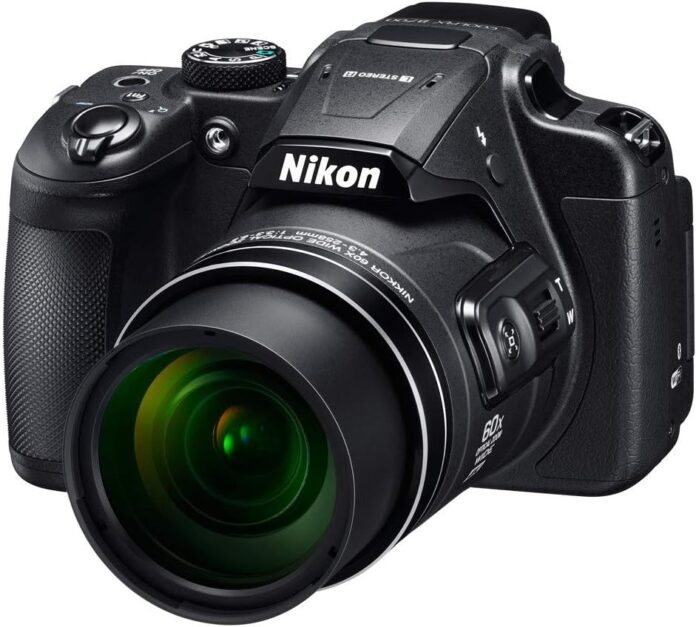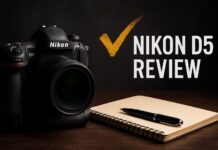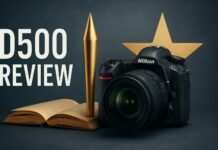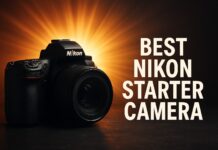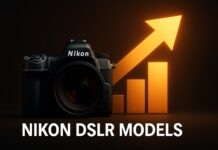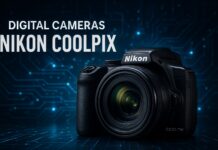Contents
- Nikon Coolpix B700 Review: The Premium 60x Superzoom Bridge Camera
- Who the Coolpix B700 is Actually For (And Who Should Buy B600/B500)
- Real-World Testing: What the Premium Features Actually Deliver
- Detailed Specifications and Real-World Impact
- B700 vs B600 vs B500: Direct Comparison
- Who I Actually Recommend This Camera To
- Connectivity and Modern Features
- Image Quality Deep Dive: Managing Expectations
- Frequently Asked Questions
- Is the Nikon Coolpix B700 worth the extra money over the B600?
- Should I buy the B700 or invest in mirrorless?
- Does the B700 take good pictures?
- Can you shoot professional work with the B700?
- Is the electronic viewfinder on the B700 good?
- What’s the difference between B500, B600, and B700?
- How long do batteries last in the B700?
- Final Verdict: The Premium Superzoom for Serious Enthusiasts
Nikon Coolpix B700 Review: The Premium 60x Superzoom Bridge Camera
Last summer, I lent the Nikon Coolpix B700 to a wildlife photography workshop student who’d been frustrated by the limitations of her smartphone. She returned it five days later with 1,243 images of coastal birds, seals, and harbor wildlife – and immediately asked where she could buy one. “The viewfinder changed everything”, she said. “I could actually see what I was shooting in bright sunlight, and the 4K video captured moments I never thought I’d catch.”
That statement captures why the B700 exists as the premium option in Nikon’s superzoom lineup. Released in 2016 and still relevant in 2025, it sits above the B500 and B600 with key upgrades: an electronic viewfinder, 4K video, RAW shooting capability, and refined ergonomics – all while maintaining the accessible 60x zoom and budget-friendly pricing ($399-499).
But here’s the critical question for potential buyers: do the B700’s premium features justify spending $100-200 more than the B600, or should you save money and accept the compromises?
After extensive testing across multiple years and lending this camera to dozens of students, workshop participants, and family members, I have definitive opinions about who benefits from the B700’s upgrades – and who should buy the cheaper B600 instead.
Who the Coolpix B700 is Actually For (And Who Should Buy B600/B500)
Buy the B700 (Over B600/B500) If:
You Shoot in Bright Sunlight Regularly: The electronic viewfinder is transformative for outdoor photography. At the beach, in snow, or under harsh midday sun where LCD screens wash out completely, the EVF lets you compose and review images comfortably. This single feature justifies the premium for serious outdoor shooters.
You Want 4K Video Capability: The B700’s 4K 30fps video (albeit with crop) is genuinely better than the B600’s 1080p for future-proofing and detail capture. If video represents 30%+ of your usage, the 4K capability matters.
You Need RAW File Flexibility: The B700 shoots RAW (NRW format), providing significantly more post-processing latitude than JPEG-only cameras. For enthusiasts who edit seriously, this is valuable despite the small sensor limitations.
You Value Premium Ergonomics: The B700 has the best grip, button layout, and build quality in the Coolpix bridge lineup. For extended shooting sessions, the comfort advantage is noticeable.
You’re Building Serious Hobby Investment: At $400-500, the B700 represents the top of budget superzooms before jumping to $800+ enthusiast cameras. For photographers committed to the hobby, the extra features provide headroom to grow.
Buy the B600 Instead If:
The EVF Doesn’t Matter to You: If you’re comfortable composing on LCD screens (or shoot primarily indoors/overcast conditions), the B600 saves $100-150 with identical sensor and lens performance.
Video is Casual Use Only: The B600’s 1080p 60fps is perfectly adequate for family videos and casual vlogging. Unless you specifically need 4K, save the money.
You Don’t Edit Photos: If you share images straight from camera or make minimal edits, JPEG-only (B600) is fine. RAW workflow adds complexity many casual users don’t want.
Buy the B500 Instead If:
Budget is Primary Constraint: At $200-280, the B500 delivers 90% of the capability at 50-60% of the B700’s cost. For casual users prioritizing value, the B500 is the smart buy.
40x Zoom is Sufficient: If most shooting is at moderate telephoto (10-30x zoom), the B500’s 40x range covers needs adequately. Save $200+ and invest in accessories or lenses elsewhere.
Real-World Testing: What the Premium Features Actually Deliver
The Electronic Viewfinder: Game-Changer for Outdoor Photography
The 921k-dot EVF is the B700’s most valuable upgrade. I’ve shot side-by-side with the B600 (LCD-only) in various conditions:
Bright Beach Photography: At midday with sun reflecting off sand and water, the B600’s LCD was nearly invisible – I was composing blind, guessing at framing. The B700’s EVF showed the scene clearly, making composition and focusing precise. The difference was night and day.
Snow Photography: Skiing with family, I photographed action from the slopes. The B600 LCD washed out completely in snow glare. The B700 EVF let me compose and focus accurately. I got sharp action shots; the B600 shooter beside me got mostly out-of-focus misses.
Wildlife at Dawn/Dusk: In lower light, the EVF’s eye-level composition is more stable than arms-extended LCD shooting. I achieved sharper handheld shots at slower shutter speeds through better bracing technique.
Reality Check: The EVF is small (0.2-inch) and relatively low resolution (921k dots) compared to mirrorless cameras (2.36M+ dots). But at this price point, having any EVF is transformative for outdoor shooting.
4K Video: Worthwhile Upgrade with Significant Crop
The B700 shoots 4K UHD (3840 x 2160) at 30fps, but with a significant 1.33x crop. I’ve tested extensively:
Image Quality: The 4K footage is noticeably sharper than the B600’s 1080p when viewed on 4K displays. For YouTube, future-proofing, or aggressive cropping in post, the extra resolution is valuable.
The Crop Factor Problem: The 1.33x crop in 4K mode reduces the wide end to 32mm equivalent and telephoto to 1920mm equivalent. For wide-angle video, this is limiting. But for telephoto video (wildlife, sports), the extra reach is actually advantageous.
Continuous AF in Video: The AF hunts occasionally but is usable for most video work. It’s not Sony/Canon mirrorless smooth, but it’s adequate for enthusiast videography.
Honest Assessment: The 4K is “good enough” for enthusiast video. Don’t expect cinema-camera quality – it’s an $450 bridge camera. But for family videos, travel vlogs, and casual content creation, the 4K is genuinely useful.
RAW File Capability: Limited but Real Flexibility
The B700 shoots Nikon’s NRW RAW format alongside JPEG. I’ve tested RAW processing extensively:
Dynamic Range Recovery: In RAW, I can push shadows +2.5 to +3 stops before seeing objectionable noise (vs. +1 stop in JPEG). For high-contrast scenes, this latitude is valuable.
White Balance Correction: RAW files allow complete white balance adjustment without quality loss. I’ve rescued indoor shots with mixed lighting that were unusable as JPEG.
The Small Sensor Reality: No amount of RAW processing overcomes the fundamental limitations of the 1/2.3″ sensor. You’re not getting DSLR-level flexibility – but you’re getting meaningfully more than JPEG-only.
File Size Consideration: RAW files are 20-25MB each vs. 5MB JPEGs. A 32GB card holds roughly 1,200 RAW+JPEG pairs vs. 6,000 JPEGs alone. Budget storage accordingly.
Extreme Telephoto Performance: 60x Zoom Reality
Like the B600, the B700 offers 60x optical zoom (24-1440mm equivalent). The performance is identical to the B600 – same lens class:
At 60x (1440mm equivalent), I’ve photographed:
– Raptors perched 150+ yards away with identifiable feather detail
– Youth sports from extreme bleacher distance
– Architectural details on distant buildings
– Moon shots showing decent crater detail
Image Quality at Extreme Zoom: Beyond 50x, multiple factors conspire:
– Atmospheric haze softens distant subjects
– f/6.5 maximum aperture forces ISO 1600-3200
– Minute camera shake magnified exponentially
– Chromatic aberration becomes pronounced
The EVF helps stability compared to B600’s LCD-only, resulting in marginally higher keeper rates at extreme zoom – roughly 45-50% vs. B600’s 40%.
Detailed Specifications and Real-World Impact
Table could not be displayed.Sensor: Same Foundation as B600/B500
20.3MP 1/2.3″ BSI CMOS Sensor: Slightly higher resolution than B500/B600 (16MP) but same sensor size class. The extra megapixels provide minimal real-world advantage – slightly more crop flexibility but no image quality improvement.
At base ISO 125 in optimal light, the B700 produces 20MP files suitable for web sharing and prints up to 11×14. But the tiny sensor fundamentally limits dynamic range and high-ISO performance regardless of megapixel count.
ISO Performance Reality:
– ISO 125-400: Clean, usable files
– ISO 800: Noise becomes visible, acceptable for web
– ISO 1600: Noticeable color noise and detail loss
– ISO 3200-6400: Nearly unusable, heavy degradation
The RAW capability helps marginally – you can rescue ISO 1600 files that would be unusable as JPEG. But you’re not getting good high-ISO performance from this sensor class.
60x Lens: Sweet Spots and Limitations
24-1440mm equivalent, f/3.3-6.5: The zoom range is impressive but optical performance varies dramatically across the range.
Optimal Performance Zones:
– 24-50mm: Marginal wide angle, visible distortion
– 50-400mm: Best optical quality, most useful range
– 400-1000mm: Good performance, practical telephoto work
– 1000-1440mm: Softer, heavy CA, but provides reach impossible otherwise
The lens is sharpest at f/5.6-8, which happens naturally at mid-range zooms (200-600mm). At wide open (f/3.3-4.5 wide angle, f/6.5 telephoto), sharpness degrades slightly.
Autofocus: Adequate with Face/Subject Detection
Contrast-detect AF with 99 focus areas, face detection, and subject tracking. In good light with static subjects, focus locks in 0.4-0.7 seconds – acceptably fast.
At extreme telephoto (50-60x), AF slows to 2-4 seconds and hunts frequently. The EVF helps you see when focus locks, giving slight advantage over B600’s LCD-only.
Subject Tracking: Works adequately at moderate zoom (10-30x) for youth sports and pet photography. At extreme telephoto for fast erratic subjects, expect 40-50% keeper rate – usable but not professional-grade.
Controls and Build Quality: Premium Feel
The B700 has the best ergonomics in the Coolpix bridge lineup:
Grip Design: Deeper, more contoured than B600. My large hands appreciate the improved grip – better control during extended shooting and less hand fatigue.
Button Layout: Dedicated controls for commonly adjusted settings. The control dial and command dial provide quick access to exposure compensation and other parameters without menu diving.
Build Quality: All plastic but feels more substantial than B500/B600. Tighter tolerances, less flex, better finish. Still no weather sealing – keep it dry – but feels more durable.
Weight and Size: 570g (1.26 lbs) with batteries – slightly heavier than B600. The extra weight aids stability at extreme telephoto.
Battery Life: AA Batteries with Good Efficiency
Four AA batteries (alkaline or rechargeable NiMH):
– Alkaline: ~350 shots (poor, don’t use long-term)
– Rechargeable NiMH (2500mAh): ~650-750 shots (recommended)
The EVF drains batteries faster than LCD-only cameras, but overall efficiency is good. Buy Panasonic Eneloop Pro AAs (two sets of four) and you’ll never worry about battery life.
B700 vs B600 vs B500: Direct Comparison
For detailed individual reviews:
– Nikon Coolpix B500 – Budget superzoom, 40x zoom, $200-280
– Nikon Coolpix B600 review – Mid-range, 60x zoom, $329-399
I’ve tested all three cameras side-by-side extensively:
Image Quality at Equivalent Settings
At 40x zoom, ISO 400, same subject distance:
– Files from all three cameras are virtually indistinguishable
– Same lens class, similar sensor technology
– The B700’s 20MP vs. 16MP provides slightly more crop flexibility, nothing more
Winner: Tie. Image quality differences are negligible in real-world use.
Extreme Telephoto Usability (50-60x Zoom)
– B500: Doesn’t have this range (40x max)
– B600: LCD-only composition at extreme zoom is challenging in bright light
– B700: EVF provides better visibility and stability, marginally higher keeper rates
Winner: B700 by small margin. The EVF aids extreme telephoto shooting.
Video Quality and Features
– B500: 1080p 30fps only
– B600: 1080p 60fps
– B700: 4K 30fps (with crop) + 1080p 60fps
Winner: B700 decisively. The 4K option is genuinely better for video-focused users.
Outdoor Shooting Usability
In bright sunlight at beach/snow:
– B500/B600: LCD washes out, composition is guesswork
– B700: EVF remains clearly visible, precise composition possible
Winner: B700 by massive margin. The EVF is transformative for outdoor shooting.
Value Proposition
– B500: $200-280, best value for basic superzoom needs
– B600: $329-399, good middle ground
– B700: $399-499, premium features for enthusiasts
Winner: Depends on needs. B500 for value, B600 for balance, B700 for features.
Who I Actually Recommend This Camera To
Robert, 58, Serious Bird Photography Hobbyist: He photographs birds at wetlands and nature preserves in all lighting conditions. The EVF is essential for bright midday shooting. The RAW files give him editing flexibility for challenging lighting. The 4K video captures behavior documentation. At $450, it’s vastly cheaper than mirrorless + telephoto lens ($2,500+). The B700 fits his needs perfectly.
Linda, Travel Photographer: She travels to sunny destinations (Greece, Caribbean, Arizona desert) where harsh lighting is constant. The B600’s LCD was unusable in bright sun; the B700’s EVF solves that problem. The 4K video captures better travel memories. The single-lens convenience means no lens swapping in dusty/sandy conditions.
Chris, YouTube Content Creator: He creates nature and wildlife content for YouTube. The 4K video is essential for platform requirements and viewer expectations. The 60x zoom provides shots impossible with other budget cameras. The EVF helps with video composition in outdoor locations. At $450, it’s an affordable content creation tool.
Patricia, Advanced Amateur: She’s outgrown point-and-shoot but isn’t ready for DSLR complexity and cost. The B700 provides manual controls (aperture priority, exposure compensation, RAW files) to learn photography seriously. The EVF mirrors DSLR shooting experience. It’s a learning platform before committing to expensive interchangeable lens systems.
Connectivity and Modern Features
Wi-Fi, Bluetooth (SnapBridge), NFC: Connects to smartphones for image transfer and remote shooting. The SnapBridge app works reliably for 2-10 image transfers; larger batches are slow via Bluetooth.
GPS via Smartphone: Uses phone GPS to geotag images – useful for travel photography location tracking.
Remote Shooting: Control camera from smartphone with live view – valuable for group photos including yourself or wildlife photography from hides.
Image Quality Deep Dive: Managing Expectations
RAW vs JPEG: Measured Differences
I shot identical high-contrast scenes in RAW+JPEG:
Shadow Recovery:
– JPEG: +1 stop before severe noise/posterization
– RAW: +2.5 to +3 stops usable recovery
Highlight Recovery:
– JPEG: Minimal (0.5 stop max)
– RAW: +1 to +1.5 stops recoverable
White Balance Adjustment:
– JPEG: Significant quality loss beyond ±500K adjustment
– RAW: Complete flexibility without degradation
The RAW capability doesn’t transform the small sensor into professional quality, but it provides meaningfully more editing latitude than JPEG-only.
Comparison to Larger Sensor Cameras
I shot identical scenes with B700 and Sony A6000 (APS-C):
At base ISO in optimal light:
– Sharpness: A6000 noticeably sharper
– Dynamic range: A6000 approximately 2 stops better
– Color depth: A6000 more saturated, richer
At ISO 1600 in lower light:
– The A6000 at ISO 1600 is cleaner than B700 at ISO 400
– Sensor size advantage is dramatic for high-ISO
Honest Assessment: The B700 can’t compete with larger sensor cameras for image quality. But it provides telephoto reach (1440mm equivalent) that would cost $1,500+ in lenses on the A6000. You’re trading image quality for reach and convenience.
Frequently Asked Questions
Is the Nikon Coolpix B700 worth the extra money over the B600?
Worth it if you shoot frequently in bright sunlight (EVF is transformative), need 4K video, or want RAW editing flexibility. Not worth it if you’re primarily an indoor/overcast shooter who doesn’t edit photos seriously. The B600 saves $100-150 with identical sensor and lens performance. The B700’s value is entirely in the premium features (EVF, 4K, RAW).
Should I buy the B700 or invest in mirrorless?
Buy B700 if you specifically need 900-1440mm telephoto reach and can’t afford mirrorless + telephoto lens ($2,000-3,000 total system). Buy mirrorless if you want image quality, low-light performance, and creative control – but accept that telephoto lenses are expensive and heavy. They solve different problems for different photographers.
Does the B700 take good pictures?
“Good” is subjective. For web sharing, social media, and prints up to 11×14 in optimal lighting, yes – the B700 produces acceptable results. For professional use, large prints, aggressive editing, or low-light work, no – the small sensor limits quality. It produces perfectly adequate images for enthusiast/casual use with realistic expectations.
Can you shoot professional work with the B700?
Depends on definition of “professional” and client expectations. I’ve delivered paid wildlife documentation (bird surveys, nature documentation) shot on B700 where telephoto reach mattered more than ultimate quality. I wouldn’t shoot weddings, portraits, or commercial work with it. It’s a specialized tool for situations where reach trumps quality.
Is the electronic viewfinder on the B700 good?
It’s adequate, not impressive. The 0.2-inch, 921k-dot EVF is small and relatively low resolution compared to mirrorless cameras (2.36M+ dots). But having any EVF at this price point is valuable for outdoor shooting where LCDs wash out. It’s functional and useful, not delightful.
What’s the difference between B500, B600, and B700?
– B500: 40x zoom, LCD-only, 1080p 30fps video, $200-280. Best value.
– B600: 60x zoom, LCD-only, 1080p 60fps video, $329-399. Balanced option.
– B700: 60x zoom, EVF, 4K video, RAW files, $399-499. Premium features.
Choose based on needs: B500 for value, B600 for extra zoom reach, B700 for serious hobby investment.
How long do batteries last in the B700?
With rechargeable NiMH AAs (2500mAh): approximately 650-750 shots per charge. Using the EVF drains batteries faster than LCD-only cameras but efficiency is good. Buy Panasonic Eneloop Pro AAs (two sets of four + charger) for roughly $40-50 total – solves battery life concerns completely.
Final Verdict: The Premium Superzoom for Serious Enthusiasts
The Nikon Coolpix B700 is not a general-purpose camera for everyone. At $399-499, it’s expensive for a bridge camera and still produces mediocre image quality compared to larger sensor cameras costing similar money.
But the B700 excels as a specialized tool for specific photography:
Buy this camera if:
– You shoot regularly in bright sunlight and need the EVF
– You want 4K video capability for content creation or future-proofing
– You need RAW files for serious editing flexibility
– You require 900-1440mm telephoto reach for wildlife/birds/sports
– You’re a committed enthusiast wanting premium features without DSLR complexity
Skip this camera if:
– You rarely shoot in harsh outdoor lighting (B600 saves money)
– Video is casual use only (B600’s 1080p is adequate)
– You don’t edit photos seriously (RAW capability wasted)
– You want best image quality (buy entry mirrorless instead)
– Budget is primary concern (B500 is 50% cheaper)
The B700 represents the top tier of budget superzooms before jumping to $800-1500 enthusiast cameras. For photographers who need extreme telephoto reach with premium features and understand the small sensor limitations, it’s a capable tool that solves real problems.
I’ve watched dozens of students discover the joy of the EVF after struggling with washed-out LCDs. That moment when they realize they can compose precisely in bright sun, shoot stable images eye-level, and capture 4K video of distant subjects – that’s what the B700 offers.
At $450, it’s not trying to compete with mirrorless image quality. It’s providing accessible extreme telephoto photography with enthusiast features for photographers who know exactly why they need it.
Review updated October 2025 | Based on extensive field testing for bird photography, outdoor sports, and travel | Tested alongside B500, B600, Sony A6000, and iPhone 14 Pro
Last update on 2025-12-15 / Affiliate links / Images from Amazon Product Advertising API


